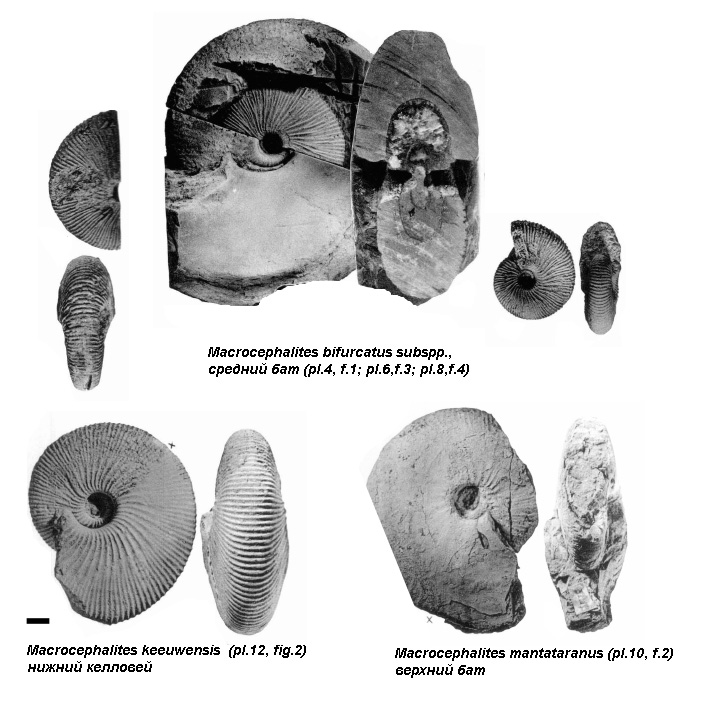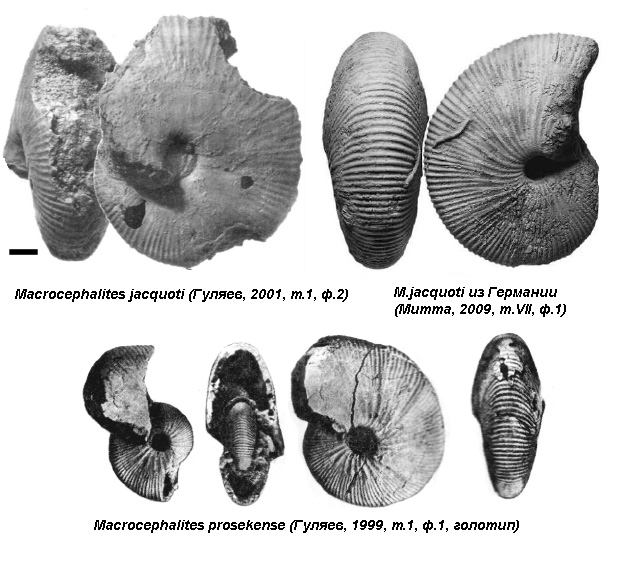Mitta V.V. (2009) Genus Eckhardites Mitta (Cardioceratidae, Ammonoidea) from the Lower Callovian of the Subboreal Jurassic // Paleontological Journal, 2009, Vol. 43, No. 1, pp. 50–58. Pdf: http://rogov.zwz.ru/Mitta,%202009_Eckhardites_engl.pdf
Discussion of strange Subboreal ammonites which were separated as cardioceratid genus Eckhardites by Mitta but considered as macrocephalidit offspring by other Russian ammonitologists (Gulyaev, Kiselev, Rogov) is continued.
Here I will present my opinion as a reply for Mitta’s sentences:
V.Mitta (VM): “In Jurassic ammonites, differences of the generic rank and more so of the familial rank are usually well pronounced at early stages, at a diameter of 15–20 mm. At this ontogenetic stage, M. jacquoti is characterized by strongly inflated whorls with a rounded cross-section with a wide venter” (p.51)
M.Rogov (MR): First of all, Mitta never compared other macrocephalitids than lowermost Callovian M.jacuoti with his “Eckhardites”. And he compared Eckhardites only with latest Cardioceratids. Secondly, families and subfamilies in Jurassic ammonites mainly recognized by differences in their sutural onthogeny. This feature more or less well studied in true Macrocephalites, but these data are absent for Eckhardites. And proximity or differences of inner whorls not always serves as a good feature for recognition of different genera: within quick evolved lineages remarkable differences could be traced through few successive species belonging to single (Funiferites) or closely related (Cad. elatmae - Cadochamoussetia – Chamoussetia) genera.
Mitta figures inner whorls of German Macrocephalites ex gr. jacquoti, focusing mainly in their thick whorls and low rib ratio:
VM: “The [in M.jacquoti] ornamentation at early stages is represented by relief, mainly bifurcating ribs, equally high along their entire length, which run radially across the flanks, and are slightly bent orad on the venter… At a diameter 15–35 mm, Eckhardites are characterized by flattened or moderately wide whorls, with high, arrow-shaped cross section, and with a narrow venter… At early stages, the ornamentation is represented by relatively thin ribs, arranged in bunches of 3–5 branches, running across the flanks with a strong inclination orad” (p.51)
MR: Surprisingly, Mitta’s description of the early onthogenesis in M. jacquoti well corresponds to description of the same stages…in the bulk of Lower Callovian cardioceratids! First Callovian cardioceratids with high rib ration and high cross-section appeared in the latest Early Callovian only, when “Eckhardites” extincted. But true Macrocephalites – from place of the appearance of this genus, New Guinea – showing ribs with many branches in their inner whorls and sometimes narrow section. (see figure)

Here there are true New Guinea macrocephalitids (from Westermann & Callomon, 1988)
VM: ”… species of Eckhardites are readily distinguished from Macrocephalites jacquoti at all growth stages studied and these differences are especially strongly observed in juvenile whorls. The whorl width to height ratio at the early stages is stable in the samples for each genus (the tables contain dimensions of five or six specimens of a similar (small) diameter). The inner whorls of the macroconchs of the cardioceratid subfamily Cadoceratinae, Rondiceras milaschevici (Nikitin) and Chamoussetia buckmani Callomon et Wright, are shown for comparison. Evidently, Eckhardites are morphologically more similar to these ammonites, which also have compressed whorls with a high, arrow-shaped cross section, than to Macrocephalites (p.52)
MR: again only latest representatives of “Eckhardites” compared with much more older M.jacquoti, albeit Russian M.jacquoti (figured by Gulyaev, 2001, 2005; Kiselev, Rogov, 2007), which considere by Mitta also as Eckhardites, are out of comparison. Adult M. Jacquoti from Germany and Russian Platform are very close to each other, and Russian ammonites sometimes also bear bifurcating ribs in inner whorls, while other bear polygyrate ribbing. They could belongs to different geographically separated subspecies, but not to different genera.

Examples of Russian (from Nizhny Novgorod region and Pechora basin, from Gulyaev, 1999, 2001) and german (from Mitta, 2009) M. jacquoti
VM: “The similarity with the Early Bathonian Arcticoceras is revealed in the shape of the shell, which in Eckhardites has a narrower venter. There are considerable differences in the ornamentation, i.e., phragmocones of Arcticoceras are covered by prominent, mainly bifurcating ribs, and only on the body chamber, which usually lacks ribs, some Arcticoceras possess ventral placation-ribs” (с.53)
MR: It’s truth! Arcticoceras is easily distinguisched from “Eckhardites”. And they are older in some millions of years
***
In addition to morphological evidences above we also can invoke paleobiogeographical evidences. As macrocephalitids and arcticocephalitids are of the different origin, their distribution should at least partially reflect this origin. Comparison of the basal Callovian of different sites shows that in Middle Volga area these ammonites are more numerous than in Pechora area – thus they are of the Tethyan origin.
References:
1. Gulyaev D.B. (1999) Macrocephalitina and Gowericeratina (Ammonoidea) of the Elatmae Zone and stratigraphy of the Lower Callovian of central areas of the Russian Platform // Problems of the Mesozoic stratigraphy and paleontology. Lecturing in memory of M.S.Mesezhnikov. Saint-Petersburg: VNIGRI publ. P.63-85. [in Russian] pdf: http://rogov.zwz.ru/Gulyaev,%201999_Macro&Gowericer.pdf
2. Gulyaev D.B. (2001) Infrazonal Ammonite Scale for the Upper Bathonian-Lower Callovian of Central Russia // Stratigraphy and Geological Correlation. V.9. no.1. P.65-92. pdf: http://rogov.zwz.ru/Gulyaev,%202001_LCallovian_engl.pdf
3. Kiselev D.N., Gulyaev D.B., Rogov M.A. (2003) Origin and systematic position of Funiferites, a new genus of the Callovian cardioceratid ammonites // In: Bogdanov N.A., Vasil’eva T.I., Verzbitsky V.E. et al. (Eds.). Modern questions of geology. Materials of the 3rd Lectures in Memory of Yanshine, March 26-28, 2003. Moscow: Nauchny mir. P. 220-225., 1 fig. [in Russian] pdf: http://www.rogovm.narod.ru/kiselev_et_al_2003_ebook.pdf
4. Кiselev D.N., Rogov M.A. (2007) Stratigraphy of the Bathonian–Callovian Boundary Deposits in the Prosek Section (Middle Volga Region). Article 1. Ammonites and Infrazonal Biostratigraphy // Stratigraphy and Geological Correlation. Vol.15. no.5. P.485–515. pdf:
http://rogov.zwz.ru/Kiselev,Rogov,2007_cl-bt_boundary.pdf
5. Mitta V.V. (1999) The genus Cadochamoussetia in the phylogeny of the Jurassic Cardioceratidae (Ammonoidea) // in: Olóriz F.&Rodriguez-Tovar F.J. (Eds.): Advancing Research on Living and Fossil Cephalopods: Development and Evolution: Form, Construction, and Function: Taphonomy, Palaeoecology, Palaeobiogeography, Biostratigraphy, and Basin Analysis. N.-Y.: Kluwer Academic/Plenum Publishers. P.125-136. pdf: http://rogov.zwz.ru/Mitta,1999_Cadochamousetia.pdf
6. Westermann G.E.G., Callomon J.H. (1988) Macrocephalitinae and associated Bathonian and Early Callovian (Jurassic) amminoids of the Sula islands and New Guinea // Palaeontographica. Abt. A. Bd.203. Lfg.1-3. P.1-90. pdf: http://rogov.zwz.ru/Westermann,%20Callomon,%201988_Macrocephalites.pdf

